The most decorated Wehrmacht soldier. Buttonholes and shoulder straps of generals. Braunschweig Death's Head Sign
Military insignia are present on the uniform of military personnel and indicate the corresponding personal rank, a specific affiliation with one of the branches of the armed forces (in this case, the Wehrmacht), branch of the military, department or service.
Interpretation of the concept "Wehrmacht"
These are the “defense forces” in 1935 - 1945. In other words, the Wehrmacht (photo below) is nothing more than the armed forces of Nazi Germany. It is headed by the Supreme Command of the country's armed forces, which subordinates the ground forces, the Navy and Air Force, and the SS troops. They were led by the main commands (OKL, OKH, OKM) and commanders-in-chief various types Armed Forces (since 1940 also SS troops). The Supreme Commander-in-Chief of the Wehrmacht is Reich Chancellor A. Hitler. A photo of Wehrmacht soldiers is shown below.
According to historical data, the word in question in German-speaking countries denoted the armed forces of any country. It acquired its usual meaning when the NSDAP came to power.
On the eve of World War II, the Wehrmacht numbered approximately three million people, and its maximum strength was 11 million people (as of December 1943).
Types of military signs
These include:
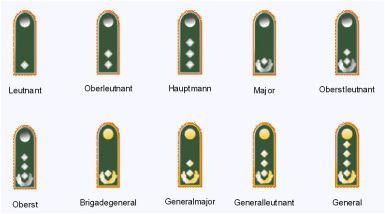
Uniforms and insignia of the Wehrmacht
There were several types of uniforms and clothing. Each soldier had to independently monitor the condition of his weapons and uniform. They were replaced in accordance with the established procedure or in case of serious damage during the training process. Military uniforms lost color very quickly due to washing and daily brushing. 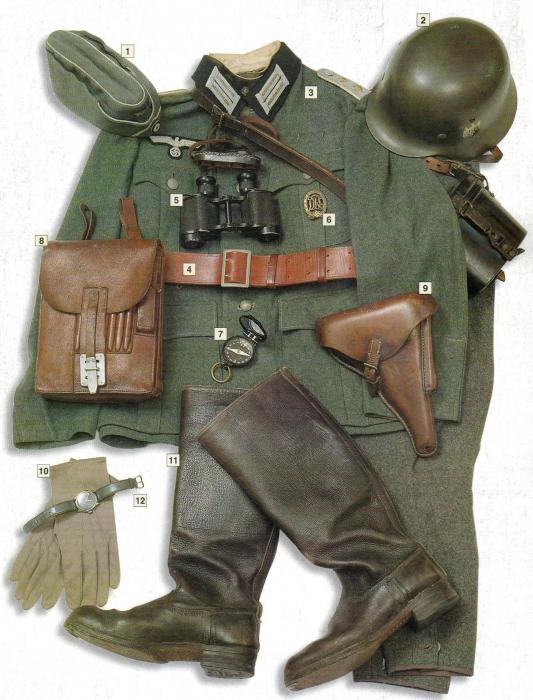
The soldiers' shoes were thoroughly inspected (at all times, bad boots were a serious problem).
Since the formation of the Reichswehr (German armed forces in the period 1919 - 1935), the military uniform has become unified for all existing German states. Its color is “feldgrau” (translated as “field gray”) - a wormwood shade with a predominant green pigment. 
A new uniform (uniform of the Wehrmacht - the armed forces of Nazi Germany in the period 1935 - 1945) was introduced along with a new model of steel helmet. The ammunition, uniforms and helmets did not differ in appearance from their predecessors (existing in the Kaiser's era).
At the whim of the Fuhrer, the attire of the military personnel was emphasized by a large number of various elements of heraldry (emblems, signs, stripes, piping, badges, etc.). Devotion to National Socialism was expressed by applying the black, white and red imperial cockade and the tricolor shield on the right side of the helmet. The appearance of the imperial tricolor dates back to mid-March 1933. In October 1935, the uniform was supplemented by an imperial eagle holding a swastika in its claws. At this time, the Reichswehr was renamed the Wehrmacht (photo was shown earlier). 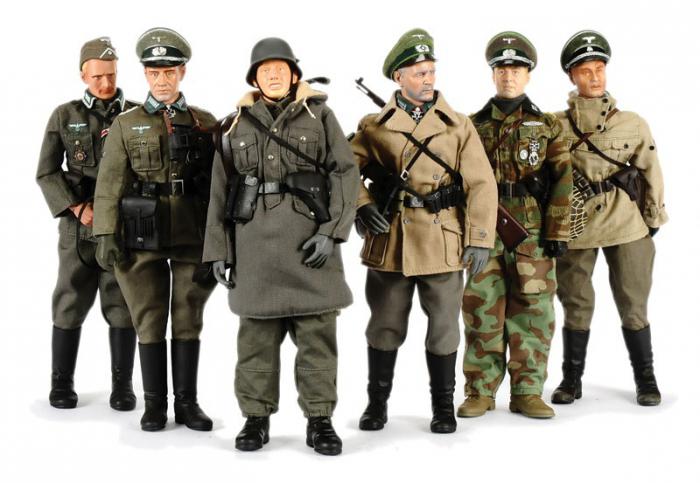
This topic will be considered in relation to the Ground Forces and SS troops.
Insignia of the Wehrmacht and specifically the SS troops
To begin with, we should clarify some points. Firstly, the SS troops and the SS organization itself are not identical concepts. The latter is the fighting component of the Nazi party, formed by members public organization, conducting their core activities parallel to the SS (worker, shopkeeper, civil servant, etc.). They were allowed to wear a black uniform, which since 1938 was replaced by a light gray uniform with two Wehrmacht-type shoulder straps. The latter reflected general SS ranks.
As for the SS troops, we can say that these are a kind of security detachments (“reserve troops” - “Totenkopf formations” - Hitler’s own troops), into which exclusively SS members were accepted. They were considered equal to Wehrmacht soldiers.
The difference in the ranks of members of the SS organization based on buttonholes existed until 1938. On the black uniform there was a single shoulder strap (on the right shoulder), from which it was possible to determine only the category of a particular SS member (private or non-commissioned officer, or junior or senior officer, or general). And after the light gray uniform was introduced (1938), another one was added distinctive feature- shoulder straps of the Wehrmacht type.
The SS insignia of both military personnel and members of the organization are the same. However, the former still wear a field uniform, which is an analogue of the Wehrmacht. It has two shoulder straps that are similar in appearance to those of the Wehrmacht, and their military rank insignia are identical. 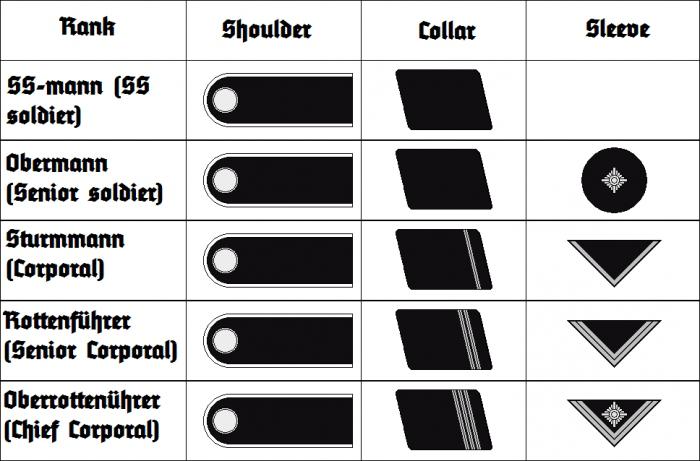
The rank system, and therefore the insignia, was subject to changes many times, the last of which occurred in May 1942 (they were not transformed until May 1945).
Military ranks of the Wehrmacht were designated by buttonholes, shoulder straps, braid and chevrons on the collar, and the last two insignia on the sleeves, as well as special sleeve patches mainly on camouflage military clothing, various stripes (gaps of a contrasting color) on trousers, and the design of headdresses.
It was the SS field uniform that was finally established around 1938. If we consider cut as a comparison criterion, we can say that the Wehrmacht (ground forces) uniform and the SS uniform were no different. The color of the second one was a little grayer and lighter, the green tint was practically not visible.
Also, if we describe the insignia of the SS (specifically the patch), we can highlight the following points: the imperial eagle was slightly above the middle of the segment from the shoulder to the elbow of the left sleeve, its design differed in the shape of the wings (there were often cases when the Wehrmacht eagle was sewn onto the SS field uniform ).

Also a distinctive feature, for example, on the SS tank uniform, was that the buttonholes, just like those of the Wehrmacht tankers, were surrounded by a pink border. The Wehrmacht insignia in this case is represented by the presence of a “dead head” in both buttonholes. SS tankmen could have rank insignia in the left buttonhole, and either a “death’s head” or SS runes in the right buttonhole (in some cases there might not have been any insignia or, for example, in a number of divisions the tank crew emblem was placed there - skull with crossed bones). The collar had even buttonholes, the size of which was 45x45 mm.
Also, the insignia of the Wehrmacht includes the way battalion or company numbers were embossed on the buttons of the uniform, which was not done in the case of military uniform SS.
The emblem of the shoulder straps, although identical to the Wehrmacht, was quite rare (the exception was the first one, where the monogram was regularly worn on the shoulder straps).
Another difference in the system accumulating SS insignia is how soldiers who were candidates for the rank of SS navigator wore a cord at the bottom of the shoulder strap of the same color as its piping. This rank is the equivalent of a gefreiter in the Wehrmacht. And candidates for SS Unterscharführer also wore a braid (braid embroidered with silver) nine millimeters wide at the bottom of their shoulder straps. This rank is equivalent to non-commissioned officer in the Wehrmacht.
As for the ranks of the rank and file, the difference was in the buttonholes and sleeve stripes, which were located above the elbow, but below the imperial eagle in the center of the left sleeve.
If we consider camouflage clothing (where there are no buttonholes or shoulder straps), we can say that the SS men never had rank insignia on it, but they preferred to wear collars with their own buttonholes over this one.
In general, the discipline of wearing uniforms in the Wehrmacht was much higher than in the troops, whose troops allowed themselves a large number of liberties regarding this issue, and their generals and officers did not strive to stop this kind of violations; on the contrary, they often committed similar ones. And this is only a small part of the distinctive features of the uniforms of the Wehrmacht and SS troops.
If we summarize all of the above, we can conclude that the Wehrmacht insignia is much more sophisticated not only than the SS, but also the Soviet ones.
Army ranks
They were presented as follows:
- privates;
- non-commissioned officers without belts (a braided or belt sling for carrying a tashka, bladed weapons, and later firearms);
- non-commissioned officers with sword belts;
- lieutenants;
- captains;
- staff officers;
- generals.
Combat ranks also extended to military officials of various departments and departments. The military administration was divided into categories from the most junior non-commissioned officers to the noble generals.
Military colors of the Wehrmacht ground forces
In Germany, branches of the military were traditionally designated by the corresponding colors of edgings and buttonholes, hats and uniforms, and so on. They changed quite often. At the beginning of World War II, the following color division was in effect:
- White - infantry and border guards, financiers and treasurers.
- Scarlet - field, horse and self-propelled artillery, as well as general's piping, buttonholes and stripes.
- Raspberry or carmine red - non-commissioned officers of the veterinary service, as well as buttonholes, stripes and shoulder straps of the Headquarters and General Staff of the High Command of the Wehrmacht and ground forces.
- Pink - anti-tank self-propelled artillery; edging of details of tank uniforms; gaps and selection of buttonholes of service jackets of officers, gray-green jackets of non-commissioned officers and soldiers.
- Golden yellow - cavalry, reconnaissance units of tank units and scooters.
- Lemon yellow - signal troops.
- Burgundy - military chemists and courts; smoke curtains and multi-barrel rocket-propelled “chemical” mortars.
- Black - engineering troops(sapper, railway, training units), technical service. Tank unit sappers have black and white edging.
- Cornflower blue - medical and sanitary personnel (except generals).
- Light blue - edgings of motor transport parts.
- Light green - military pharmacists, rangers and mountain units.
- Grass Green - motorized infantry regiment, motorcycle units.
- Gray - army propagandists and officers of the Landwehr and reserve (edging on shoulder straps in military colors).
- Gray-blue - registration service, officials of the American administration, specialist officers.
- Orange - military police and officers of the engineering academy, recruiting service (edging color).
- Purple - military priests
- Dark green - military officials.
- Light red - quartermasters.
- Blue - military lawyers.
- Yellow - horse reserve service.
- Lemon - feld post.
- Light brown - recruit training service.
Shoulder straps in German military uniform
They had a dual purpose: as a means of determining rank and as carriers of a unitary function (fastening various types of equipment on the shoulder).
Shoulder straps of the Wehrmacht (rank and file) were made of simple cloth, but with edging, which had a certain color corresponding to the branch of the army. If we take into account the shoulder straps of a non-commissioned officer, we can note the presence of an additional edging consisting of braid (width - nine millimeters).
Until 1938, there was a special army shoulder strap exclusively for field uniforms, which was worn by all ranks below officer. It was entirely dark blue-green with a slightly tapered end towards the button. There was no edging attached to it, corresponding to the color of the branch of service. Wehrmacht soldiers embroidered insignia (numbers, letters, emblems) on them to highlight the color.
The officers (lieutenants, captains) had narrower shoulder straps, which looked like two intertwined strands made of flat silver “Russian braid” (the strand is woven in such a way that thinner threads are visible). All strands were sewn onto the flap in the color of the branch of the military that is the basis of this shoulder strap. A special bend (U-shaped) of the braid in the place of the button hole helped create the illusion of eight strands of it, when in fact there were only two.
The Wehrmacht (staff officers) shoulder straps were also made using Russian braid, but in such a way as to demonstrate a row consisting of five separate loops located on either side of the shoulder strap, in addition to the loop around the button located at the top of it.
U general's shoulder straps there was a distinctive feature - “Russian braid”. It was made from two separate gold strands, twisted on both sides with one silver ribbed thread. The weaving method implied the appearance of three knots in the middle and four loops on each side in addition to one loop located around the button at the top of the shoulder strap.
Wehrmacht officials, as a rule, had the same shoulder straps as those of the active army. However, they were still distinguished by the slight introduction of a thread of dark green braid and various kinds of emblems.
It would not be amiss to remind you once again that shoulder straps are insignia of the Wehrmacht.
Buttonholes and shoulder straps of generals
As mentioned earlier, Wehrmacht generals wore shoulder straps, which were woven using two thick gold-metal strands and a silver soutache between them.
They also had removable shoulder straps, having (as in the case of ground forces) a cloth lining with a special figured cutout running along the edge of the strands (their lower edge). And the bent and sewn-in shoulder straps were distinguished by a straight lining.
The Wehrmacht generals wore silver stars on their shoulder straps, but there was some difference: major generals had no stars, lieutenant generals had one, a general of a certain type of troops (infantry, tank troops, cavalry, etc.) had two, and an oberst general had two. three (two stars located next to each other at the bottom of the shoulder strap and one slightly above them). Previously, there was such a rank as Colonel General in the position of Field Marshal General, which was not used at the beginning of the war. The shoulder strap of this rank had two stars, which were located in its upper and lower parts. A field marshal could be identified by the crossed silver batons along his shoulder straps.
There were also exceptional moments. So, for example, Gerd von Rundstedt (Field Marshal General, who was removed from command due to the defeat near Rostov, chief of the 18th Infantry Regiment) wore the regiment number on his shoulder straps on top of his field marshal's batons, as well as the white and silver ceremonial buttonholes of an infantry officer on his collar troops in return for the richly ornamented gold buttonholes embroidered on a scarlet cloth flap (size 40x90 mm) for generals. Their design was found back in the days of the Kaiser’s army and the Reichswehr; with the formation of the GDR and the Federal Republic of Germany, it also appeared among generals.
From the beginning of April 1941, elongated buttonholes were introduced for field marshals, which had three (instead of the previous two) ornamental elements and shoulder straps made of golden thickened cords.
Another sign of the general's dignity is stripes.
The field marshal could also carry in his hand a natural staff, which was made of particularly valuable wood, individually decorated, generously inlaid with silver and gold and decorated with reliefs.
Personal identification mark
It looked like an oval aluminum token with three longitudinal slots, which served so that at a certain moment (the hour of death) it could be broken into two halves (the first, with two holes, was left on the body of the deceased, and the second half with one hole was given to headquarters).
Wehrmacht soldiers wore this identification mark, usually on a chain or neck cord. The following was stamped on each token: blood type, badge number, battalion number, regiment number where this badge was issued for the first time. This information was supposed to accompany the soldier throughout his entire service life, if necessary supplemented by similar data from other units and troops.
An image of German military personnel can be seen in the photo “Wehrmacht Soldier” shown above.
Nakhodka in Besh-Kungei
According to official data, in April 2014, a treasure from the World War II era was found by citizen D. Lukichev in the village of Besh-Kungei (Kyrgyzstan). While digging a cesspool, he came across a metal army field locker. Its contents are luggage shipments from 1944 - 1945. (age - more than 60 years), which was not damaged by moisture due to dense insulation through the rubber gasket of the box lid.
It included:
- a light-colored case with the inscription “Mastenbrille” containing glasses;
- a rolled-up travel bag with pockets filled with toiletries;
- mittens, replacement collars, socks with foot wraps, clothes brush, sweater, suspenders and dust protectors;
- a bundle tied with twine containing a supply of leather and fabric for repairs;
- granules of some kind of product (presumably anti-moth);
- an almost new jacket worn by a Wehrmacht officer, with a spare sewn-on emblem of the branch of service and a metal badge;
- headdresses (winter hat and cap) with insignia;
- military passes through front-line checkpoints;
- a banknote of five Reichsmarks;
- a couple of bottles of rum;
- box of cigars
Dmitry thought about passing most uniforms to the museum. As for the bottles of rum, the box of cigars and the jacket worn by the Wehrmacht officer, he wants to keep them according to the legal 25% granted by the state when finding historical value.
Commemorative army badges for German soldiers:
Badge for the Battle of Narvik in 1940 on August 19. The award was given to all soldiers who took part in this military operation.
Badge for the Battle of the Hill on July 1, 1942. The soldiers who took part in the defense of the fortress in Demyansk were awarded.
The "Crimean Shield" badge was awarded to soldiers who distinguished themselves during military operations in the winter campaign in Crimea in 1942.
The "Demyansky Shield" badge was awarded to German soldiers who distinguished themselves in the battles for Demyansk in 1941-1942.

The Lapland Shield badge was awarded to all participants in the Battle of Lapland.
In 1944, the Warsaw Shield badge was awarded to all participants in the suppression of the uprising in Warsaw. In the troops
The Lorien Shield badge was awarded to Wehrmacht soldiers during the defense of the French city of Lorien in December 1944.
The Kuban Shield badge was awarded to Wehrmacht soldiers who distinguished themselves during the defense of Kuban on September 20, 1943.

Commemorative badges for German soldiers:
Member badge civil war in Spain. The badge was established on May 22, 1939 by the German Wehrmacht.
WW2 badge - awarded to all distinguished participants in the outbreak of hostilities in the German Wehrmacht starting in 1939.
The badge was awarded by Hitler himself after a memorable event: the assassination attempt on Adolf Hitler on July 20, 1944!!! The badge was signed personally by Hitler. A very rare award.
In addition to the insignia presented here, many others were used in the army, but this section contains the most important of them.
Memorial signs
They were supposed to remind the military units of the traditions of the old Prussian army, which ended its existence in 1918. These signs were awarded to the newly formed military units of the Reichswehr (from April 1922). and later - parts of the Wehrmacht. These signs were on caps, they were worn below the insignia (eagle with swastika). The presence of other signs is proven by photographs of that time. They were worn according to the regulations on field caps.
In memory of the former famous Prussian regiments of Life Hussars No. 1 and 2. In the Reichswehr, this honorary badge was awarded to the 1st and 2nd squadrons of the 5th (Prussian) Cavalry Regiment. According to the order of the OG on February 25, 1938, the traditions and powers of this sign were transferred to the headquarters with the trumpet corps and the 1st division of the 5th cavalry regiment. According to the requirements of modern warfare, with the outbreak of hostilities, this cavalry regiment was first disbanded, and then a reconnaissance unit of the infantry division was formed on its basis. Not to be confused with the cavalry regiments of the 1st Cavalry Division, which still survives. So from the 5th Cavalry Regiment the 12th and 32nd reconnaissance battalions, as well as parts of the 175th reconnaissance battalion, were formed. The servicemen of this unit continued to wear the “Death's Head” sign further.
According to the order of June 3, 1944, the cavalry regiment “North”, formed a year earlier, was renamed cavalry regiment No. 5. The regiment’s employees were secretly allowed to wear the traditional “Death’s Head” badge again, but without official approval. After a short time, they again received official permission to wear their former insignia.
Braunschweig Death's Head Sign
This Death's Head sign dates back to 1809 from the "Black Troop" of Duke Friedrich Wilhelm of Brauischweig-Ols. The skull was longer than on the Prussian example and rested with the upper jaw on the crossed bones. The sign was supposed to remind of the glorious military deeds of the former Brunswick military units: Infantry Regiment No. 92 and Hussar Regiment No. 17, which during the 1st World War were part of the 10th Army Corps. This honorary badge was awarded in the Reichswehr to the 1st and 4th companies of the 1st Brunswick Battalion of the 13th Infantry Regiment and the 4th Squadron of the 13th Prussian Cavalry Regiment.
By order of February 25, 1938, this badge was awarded to: headquarters, 1st and 2nd battalions and 13th and 14th companies of the 17th infantry regiment. By the same order, the 2nd division of the 13th cavalry regiment received the right to wear this sign.
The corresponding order of February 10, 1939 was supposed to replace the Braunschweig Death's Head sign with a Prussian model, but this order, like other similar ones, was unlikely to be executed. Most of the military personnel of these units continued to wear the Brunswick pattern.
On the eve of September 1, 1939, the 13th cavalry regiment was disbanded and on its basis the 22nd and 30th were created. 152nd p 158th reconnaissance battalions, whose military personnel continued to wear the previous commemorative insignia.
On May 25, 1944, the cavalry regiment "South", formed in the same year, was renamed the 41st Cavalry Regiment, which retained the tradition of the right to wear the Brunswick "Death's Head" badge. A little later, this right extended to all military personnel of the 4th Cavalry Brigade, which included this regiment. Only the 5th Cavalry Regiment of the same brigade continued to wear the Prussian Death's Head pattern.
Dragoon Eagle
In memory of the glorious victory of the 2nd Brandenburg Dragoon Regiment in the Battle of Schwedt on the Oder in 1764, the “Swedt Dragoon” badge was established; later the name was changed to “Schwedt Eagle”.
In the Reichswehr, the "Swedt Dragoon" badge was first awarded to the 4th Squadron of the 6th (Prussian) Cavalry Regiment. By 1930, the 2nd squadron also received this memorial sign. Meanwhile, during the Weimar Republic, the eagle lost its crown and ribbon with the motto: “With God for the Kaiser and the Fatherland.” With Hitler's rise to power in 1933, all this was returned. In the Wehrmacht, this badge was awarded to the headquarters. 2nd and 4th squadrons of the 6th cavalry regiment. On October 1, 1937, the 3rd Battalion of Motorcycle Riflemen received the “Swedish Eagle” badge. When the 6th Cavalry Regiment was disbanded in August 1939, the 33rd, 34th and 36th reconnaissance battalions, as well as units of the 179th reconnaissance battalion, began to wear the “Schwedt Eagle” sign.
At the end of 1944, this badge was awarded to the 3rd Cavalry Brigade; previously, only the “Center” cavalry regiment was awarded it.
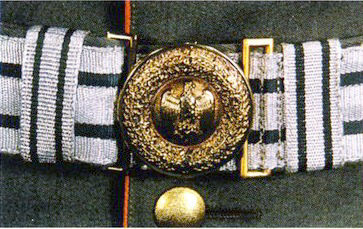 |
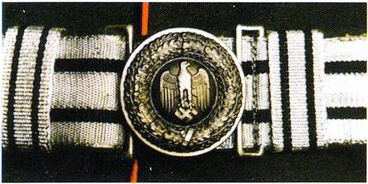 |
| Buckles, the Coat of Arms of the 3rd Reich was also located on the buckle of the waist belt and field belt: a ceremonial army belt for generals with a gold-plated buckle. | Ceremonial army belt for officers with aluminum buckle. |
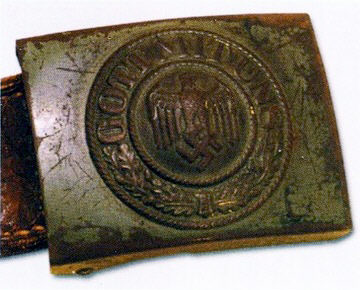 |
|
| A series of stamped sheet steel belt buckles produced after 1941. | Aluminum alloy belt buckle with grained outer surface |
Badge of the Jaeger and Mountain Rifle Units
Special signs were introduced for military personnel of mountain rifle units and ranger divisions, as well as the 1st ski ranger division. Since then, stamped metal signs were worn on headdresses, and embroidered sleeve patches on tunics, uniforms, etc.
Mountain rifle units (Mountain rangers)
Since May 1939, an oval cloth badge was worn on the right shoulder of all types of uniforms. It was an edelweiss flower embroidered on fabric with white petals and yellow stamens, with a pale green stem and leaves. The flower was framed by intertwined climbing rope, embroidered in matte gray thread, with a silver-white ringed crutch. The basis was an oval made of dark blue-green cloth. There were two versions of this badge: the highest quality - silk, machine embroidered, and the lower quality, made of felt. There is mention of badges embroidered entirely with pale green thread and copper-brown badges, also silk, machine embroidered, intended for the Afrika Korps.
On the cap, between an eagle with a swastika and a cockade, hung an edelweiss flower without a stem, made of white metal. On the left side of the mountain cap, and later on the military cap, a sign depicting an edelweiss with a stem and two leaves, made of matte white metal, was attached. There were also samples. made by hand embroidery.
Jaeger units
By order of October 2, 1942, a special huntsman badge was introduced. Like sleeve badge mountain rangers, the ranger badge with oak leaves was introduced to be worn on the upper part of the right sleeve of a zero jacket, uniform jacket or overcoat by all personnel of ranger divisions and ranger battalions. It featured three green oak leaves and one green acorn on a small brown branch, all embroidered on an oval piece of dark green fabric edged with pale green cord. This emblem also comes in two versions: higher quality, machine embroidered with silk thread, and lower quality, made of felt. Made of white metal, it was attached to the left side of the cap. This badge was worn like the edelweiss of mountain rifle units.
Soldiers of the 1st Jaeger Regiment of the Brandenburg Division wore the badge of the Jaeger units. and the soldiers of the 2nd Jaeger Regiment of the same division received the badge of mountain rifle units.
Ski Jaeger Troops
A special badge was introduced for military personnel of the 1st Ski Rangers Division, which was formed in September 1943, first under the name of the 1st Ski Rangers Brigade, in August 1944. It had the same design and colors as the Jaeger badge, but in the center It contains two intersecting copper-brown skis intertwined with green oak leaves. It was also worn on the right sleeve of the uniform by all personnel of rifle units serving in ski units.
 |
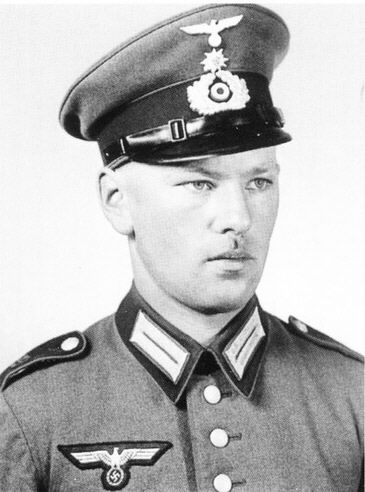 |
| Non-commissioned officer and officer candidate of the 17th Grenadier Regiment. On his right sleeve, a special sign of mountain rangers is sewn, not according to the regulations. | Mountain ranger in full dress uniform. On his cap is an edelweiss flower without a stem. |
 |
 |
Insignia of the military branches
Privates and non-commissioned officers with special education wore an embroidered badge on the right forearm of their tunic, uniform and overcoat. It was usually depicted with a symbol and a letter embroidered from golden-yellow wool on a round base of dark blue-green or gray fabric. See table 2.
Table 2. Insignia on an army shoulder strap |
|
| Special formation | Symbol or letter |
| Pigeon mail specialist | Gothic "B" |
| Fortification builder, sergeant major | Gothic "Fb" (before 1936) |
| Fortification engineer, sergeant major | Gothic "Fp" (1936-1939) |
| Craftsman or mechanic in production | gear wheel (since 1938) |
| Pyrotechnician, artillery technician | Gothic "F" |
| Radio operator | a bunch of three crossed lightning bolts |
| Gas protection non-commissioned officer | Gothic "Gu" (since 1943) |
| Supply non-commissioned officer | Gothic "C" (since 1943) |
| Blacksmith mentor | horseshoe and star inside |
| Signalman, communications service mechanic | Gothic "M" |
| Regimental saddlemaker | Gothic "Rs" (since 1935) |
| Medical service personnel | snake and rod of aesculapius |
| Saddler | Gothic "S" |
| Army saddler, saddlemaker | Gothic "Ts" |
| Non-commissioned officer of the ammunition supply service | two crossed rifles |
| Fortification construction technician, sergeant major | Gothic "W" (since 1943) |
| Assistant Treasurer | Gothic "V" |
| Communications personnel, signalman | lightning in the oval |
| Helmsman (landing craft) | anchor and steering wheel on top of it |
Soldiers who completed combat training, but were not assigned to a unit, wore horizontal braids and insignia since 1935. They were filmed after receiving the appointment.
The original standard bearer sleeve shield was established by the German Army High Command on June 15, 1898, but this emblem was not used after 1919. On August 4, 1936 it was introduced a new version the original sleeve shield of the standard bearer and standard bearer. At first it was intended to be worn on a customary sleeve, in its upper part, only on a service, field and uniform jacket, but not on an overcoat.
The last restriction, however, was then lifted, and the overcoat was included in the list of uniforms on which this shield could be sewn. The sleeve shield served as a sign that distinguished the wearer as a linden, who occupied a special position in his military unit, namely as a standard bearer. The predominant color of the sleeve shield was the color of the branch of service of the standard bearer wearing it. It was sewn onto a dark blue-green fabric base.
Along with the badges of specialists intended to be worn on the right sleeve, there was also a series of badges that were supposed to be worn on the left sleeve. These were the insignia of signalmen, artillery gunners and multi-barrel rocket artillery launchers, as well as the insignia of helmsman boats. On the left sleeve of the tunic, uniform and overcoat, special insignia were worn by landing craft helmsmen and communications personnel. Initially, they represented aluminum-colored embroidery or babbitt stamping on dark green oval-shaped fabric. In December 1936, artillery gunners' insignia began to be made from artificial silk in a matte golden yellow color. It was an upright yellow shell with a flame at the top, in a wreath of oak leaves. yellow color on an oval made of dark green fabric. The badge was worn on the lower part of the sleeve. In February 1937, a special sign was introduced for smoke screen gunners. It was an upright white mine in a wreath of white oak leaves on an oval of dark green fabric. The badge was worn on the lower part of the right sleeve.
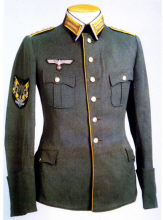 |
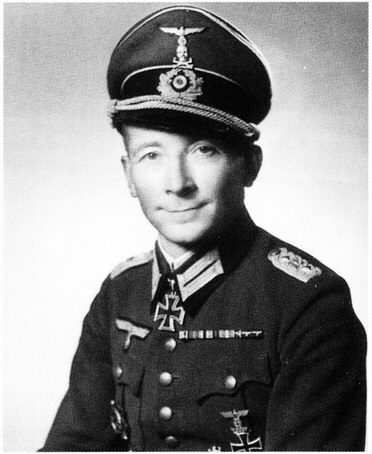 |
| The tunic of the chief sergeant of the 7th battalion of the signal service with the sign of the standard bearer and standard bearer on the right sleeve | Colonel Joachim von Stoltzmann of the 17th Infantry Regiment. He wore the Brunswick Death's Head badge on his cap, the traditional badge of his military unit. |
 |
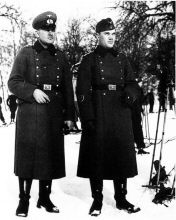 |
| It is noticeable that the soldier foreground The photograph has a double stripe on the sleeve of his field jacket corresponding to the rank of Haupt-sergeant-major. | Since 1939, non-commissioned officers who have undergone special training and hold a regular position have worn an aluminum-colored cord ring as part of this training. On the right in the picture is a saddler. It is noticeable that the yellow Gothic “S” on the dark green fabric mug is located in an aluminum-colored cord ring. The badge was worn on the lower part of the right sleeve. |
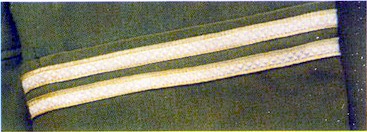 |
|
| Detail view of the "piston ring" | |
 |
|
| Fortification construction technician, sergeant major, gas defense non-commissioned officer (since 1944), pyrotechnician, artillery technician, gunner. | |
 |
|
| Medical service officer, with a silver edging (since 1939 for soldiers since 1944), medical service personnel without edging (since 1939), radio operator, smoke screen gunner. | |
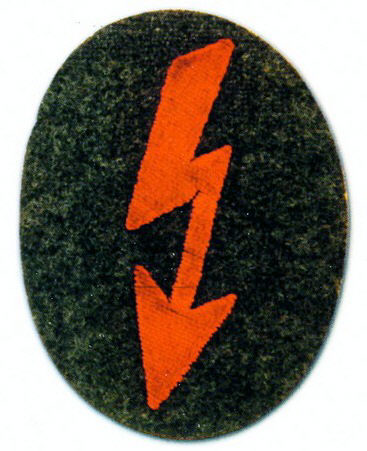 |
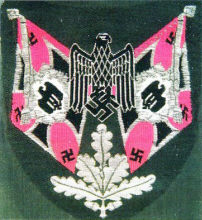 |
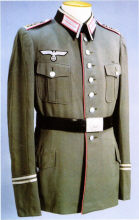 |
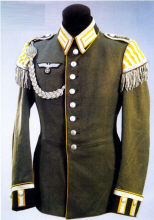 |
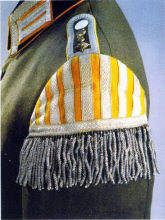 |
| Haupt-sergeant-major (company sergeant-major) or haupt-sergeant-major of the cavalry, etc. was the non-commissioned officer who was responsible for internal regulations in the company or headquarters. His rank reflected his position in service and his official function. Its distinctive sign is a double stripe on both sleeves of the jacket at the bottom (on the cuffs of the sleeves). This strip was informally called the "piston ring". The uniform jacket of the Haupt-sergeant major of the 30th anti-tank division. | The ceremonial jacket of a sergeant from the trumpeter detachment of the 8th Cavalry Rifle Regiment. | "Swallow's Nest" cavalry trumpeter, noticeable fringe decoration of 64 elements. |
Swallow's Nest (musicians' shoulder badge)
Brass band musicians, drummers and buglers wore a special sign (the so-called “swallow’s nest”) on their uniform and uniform jacket, but not on their overcoat. These were special semicircular overlays with braid sewn on them, located symmetrically on the shoulders of the uniform jacket. On the uniform, this crescent-shaped sign was sewn onto the seam of the sleeve; on the uniform, it was fastened with hooks. Each such nest was attached to the shoulder of the jacket with five long metal hooks, located at an equal distance from each other on the inner curved surface of the “swallow’s nest”.
They were inserted into five corresponding loops, sewn at equal intervals into the shoulder seam of the jacket. It consisted of a fabric base in the color of the military branches with piping or galloon at the edge. Since September 1935, this badge began to consist of 7 vertical and horizontal braids, while the new braids became thinner than the previous ones. The following variants of swallow's nests differed: drummers - gray border; musicians and trumpeters - light-alumen braid; battalion buglers - light-aluminum braid with a fringe 7 cm long.
Ceremonial and everyday aiguillette cords
The army had three types of different ceremonial cords (also called aiguillettes): aiguillettes for officers, adyotaites insignia, and riflemen's cords.
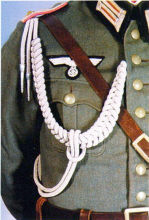 |
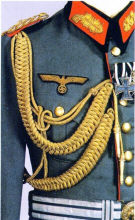 |
| The adjutant's aiguette was woven from matte aluminum cords. | Generals and officials of the same rank wore gold-colored aiguillettes, otherwise their aiguillettes did not differ from those of officers |
 |
|
| Aiguillettes, introduced for army officers in 1935, replaced the Reichswehr ones. The new aiguillettes were distinguished by the presence of a second cord and a second figured tip. For officers, the aiguillette was made from light aluminum thread, for generals - from yellow-gold artificial silk threads. The metal curly tips were of the appropriate color. The adjutant's aiguettes looked the same and were worn by officers only while performing the duties of an adjutant. | Uniform jacket of Lieutenant General Max Denerlein with a large medal block |
Officer's aiguillettes
They were introduced into the Reichswehr on July 22, 1922 and were initially worn only on ceremonial uniforms. The harness and both loops were made of light silver or aluminum thread. Generals wore aiguillettes made of gold thread. It was attached to the officer's shoulder strap on one side and on the other on the 2nd and 3rd buttons of the uniform.
By order of June 29, 1935, a second cord was added and both cords ended with a metal figured tip. Introduced on June 29, 1935, the officer's aiguillette is nothing more than a decoration for the dress and dress uniform. There were silver and golden aiguillettes, shoulder straps, weaving, and those... what bandmasters wore when conducting. were distinguished by red stitching in silver cords. A long braided aiguillette and a folded sleeve cord ran through the right side onto the chest. A loop of wattle was thrown over the third button of the uniform from the top, and a bent cord knotted around a pair of breast cords with curly tips hanging freely along the side. The short wattle hung below the chest cords and was fastened to the second button. Under the shoulder strap there was a button or button for fastening a leather strap sewn to the junction of the cords and the wickerwork.
From July 9, 1937, officers began to wear aiguillette for their ceremonial uniform if Hitler himself, the Supreme Commander of the Wehrmacht, was present at the parade. It was also supposed to be worn at parades dedicated to the Fuhrer’s birthday. It was worn in ceremonial uniforms and on certain occasions, for example, during ceremonial events, ceremonial marches, etc. However, aiguillettes were never worn on overcoats.
Aiguillette of Adjutants
We are talking about insignia directly related to the official duties of an adjutant, who belonged to the command (staff) structure of the troops. For example, the adjutant of the headquarters of a regiment, battalion or company. Since 1935, a wide bundle of two thin cords has been made from matte aluminum thread.
Aiguillette awarded to adjutants of generals. staff officers, worn while on duty. It consisted only of a chest braid, covered in the middle by a loop of a sleeve cord, the ends of which extended from under the right shoulder strap onto the chest with two tips hanging along the armhole line of the sleeve. The end of the aiguillette was fastened to the second button from the top of the uniform (or casual tunic, field jacket, overcoat). He leaned towards the right shoulder strap on one side and towards the first button of his jacket on the other side. However, the aiguillette was worn only while the officer served as adjutant.
Aiguillettes for excellent shooting
The Reichswehr had 10 initial levels of awards for shooters for excellent shooting. By order of January 27, 1928, such levels became 24. These awards were awarded to soldiers and non-commissioned officers for success in shooting with a carbine, rifle, light and heavy machine guns. as well as successes in the development of mortar and artillery weapons (military personnel of mortar and artillery companies. These were matte braids that were worn on the sleeve in the area of the left forearm.
By order of June 29, 1936, instead of these signs, aiguillettes were introduced for excellent shooting. When creating its sample, the traditions of the old army were used. The cord was made of threads of matte aluminum color, the matte sign with a pattern was stamped from aluminum alloy. There were 12 steps. For each of the 4 steps there was a specific sign.
Another difference was the presence of acorns at the lower end of the cord. They were woven from threads of gold or aluminum color, the number of acorns corresponded to a row from 10 to 12 degrees.
Badges for excellent shooting were worn on ceremonial, uniform, weekend and guard uniforms, but not on overcoats. The end of the cord with the sign was attached under the right shoulder strap with a button, the other end of the cord was fastened to the second button of the tunic or uniform.
Along with factory ones, there were handmade aiguillettes, which were distinguished by deviations from the standard in execution. Most of them were made from aluminum-colored threads. Over time, these deviations were approved, for example, aiguillettes received metal shells instead of acorns for the excellent shooting of artillerymen from December 16, 1936.
On October 17, 1938, a special sign for tank crews was introduced. From the 1st to the 4th stage it depicted the Pz.Kpfw.I tank under the Wehrmacht eagle. At the same time, the sign was framed by an oval of stylized caterpillar tracks. For steps from 5 to 8 the crown was made of oak leaves. The sign of the steps from 9 to 12 was the same. but was made of gold-colored metal. Shells made of aluminum or gold-colored metal were hung from the lower end of the tankers' aigullant for excellent shooting.
Finally, in January 1939, a new badge appeared for the first three levels for excellent shooting. It was the same as for steps 5-8, but had a narrower wreath.
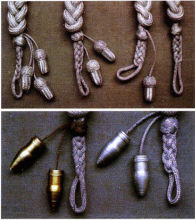 |
 |
 |
| Signs to distinguish individual levels were in the form of shells for artillerymen, for other branches of the military - in the form of acorns. For grades 9-12 they were gold in color | Aiguillette “For excellent shooting”, 1st stage. At the top there was a heeled stamping made of aluminum alloy. The picture shows a sample from 1939. | 1. Three different badges for tank troops “For excellent shooting.” From right to left: steps 1-4,5-8 and 9-12. 2. Three different marks for shooters “For excellent shooting” (sample January 1939), which were attached to the aiguillette. From right to left: steps 1 -4.5-8 and 9-12. |
She was worn on a ceremonial uniform and uniform jacket, but only on orders. This insignia was sewn onto the fabric of the uniform in the form of a block of zinc tin 4 cm wide. It was strengthened so that the block covered the patch.
The sequence of orders and insignia on the order block |
|
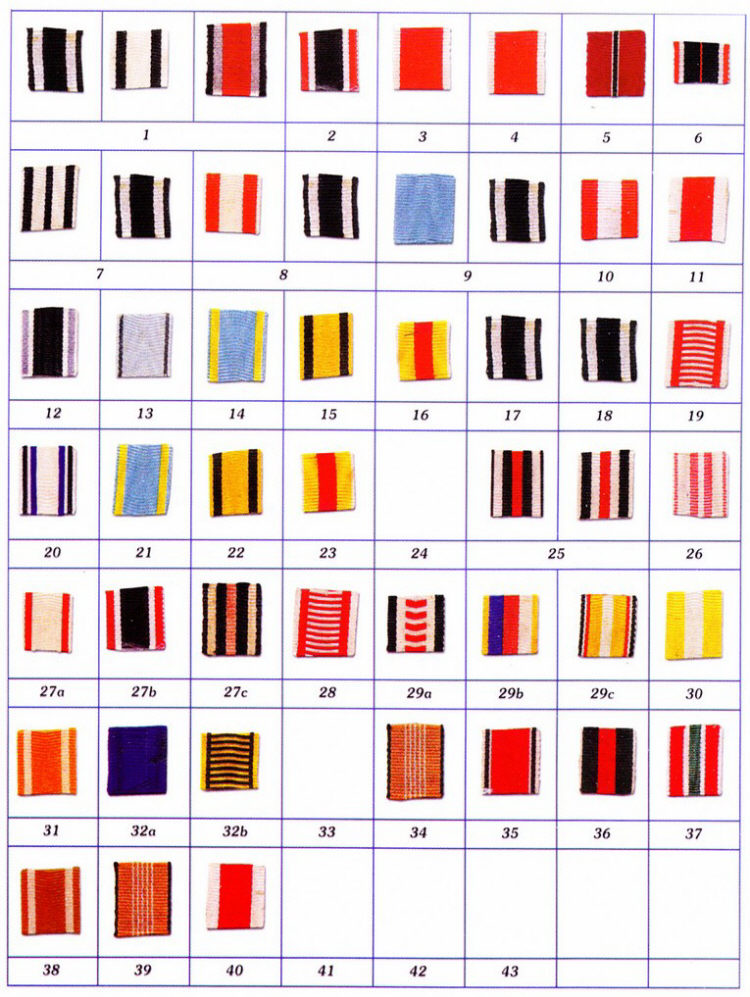 |
|
| The attached list shows the order in which the various orders and insignia were worn on the medal block. The attached instructions from 1943 differ from those issued in 1935 and 1937 primarily in the appearance of 6 new awards (in the list these are numbers 2 and 38). This list primarily concerns the awards of all Wehrmacht military personnel; there may be some changes made at a later time. 1. Iron Cross model 1914 and 1939. 2. Cross of military merit with swords (for military distinction) and without swords. 3. Insignia “For caring for the German people” with swords on a ribbon. 4. Medal “For Care of the German People” with swords on a ribbon. 5. Medal “FOR THE WINTER CAMPAIGN IN THE EAST 1941-42” 6. Military Merit Medal. 7. Royal Order of the House of HOHENZOLLERN (Prussia) 8. Prussian Order of the Red Eagle 3rd or 4th class with swords. 9. Order of the Crown of Prussia, 3rd or 4th class. 10. Austrian Military Order of Maria Theresa. 11. Austrian Imperial Order of Leopold with military honors. 12. Bavarian Military Order of Maskimilian Joseph. 13. Bavarian Military Order of the Red Cross. 14. Saxon Military Order of St. Henry. 15. Württemberg Order of Military Merit. 16. Baden Military Order of Merit of Karl Friedrich. 17. Prussian gold Cross of Military Merit. 18. Prussian military medal 1st and 2nd grades. 19. Austrian Golden medal"For bravery" 20. Bavarian gold and silver medals for bravery. 21. Saxon gold medal of the Order of St. Henry. 22. Württemberg Gold Medal of Military Merit. 23. Baden Military Merit Medal of Karl Friedrich. 24. Other orders and insignia for service in the 1st World War in the ranks of your corps and within the same class the day after the award. 25. Cross of Honor of the 1st World War. 26. Austrian commemorative medal dedicated to the 1st World War. 27a. Commemorative coin of the war of 1864 276. Memorial Cross 1866 27s. Commemorative coin of the war of 1870-71. |
28. Austrian war medal. 29th century South West Africa Commemorative Coin (Colonial Award) 296. Colonial Commemorative Coin. 29s. China Commemorative Coin (Colonial Award). 30. Silesian Badge of Merit (Silesian Eagle) 31. Medal “For Salvation” on a ribbon. 32a. Service badge of the Wehrmacht. 326. Austrian Military Service Badge. 33 Other state awards and awards of the NSDAP according to the degree of their significance and within the same level the day after the award. 34. Award for Olympic merit. 35. Commemorative medal March 13, 1938 36. Commemorative medal October 1, 1938 37. Medal in memory of the return of Memel. 38. Western Wall Medal of Honor. 39. German commemorative Olympic medal. 40.Honorary badge of the German Red Cross. 41. Order and honorary badge of the former German sovereign states in the ranks of their class and within the same class one day after the award. 42. Foreign orders and medals were arranged in a row as they were awarded. |
On this medal block, which was worn on all other types of uniforms. there were only medal ribbons. They were located next to each other on a block 12-18 mm wide. It was made of aluminum sheet or plastic, sometimes even leather. Along with the traditional method of attaching order ribbons, the Bavarian method was also used, when the ribbons were laid in twos and placed one after another, due to which the entire block gave the appearance of a wider one.
 |
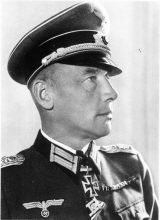 |
| Lieutenant Colonel in a ceremonial jacket - on the left chest there is a large order block | Knight's Cross holder Major General Georg-Wilhelm Postel wore a small order block with a leather lining |
 |
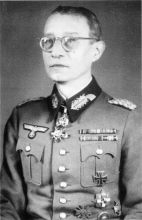 |
| Small medal block of a participant in the 1st World War. | This magnificently decorated major general wore two small medal blocks, located on top of each other. |
 |
 |
| Small order block with the Bavarian method of laying order ribbons |
- Why do you dream about a witch, dream book, interpretation of dreams online
- Planting something in a dream - what could it mean?
- Why do you dream that a man is cooking, what does the dream symbolize?
- Why do you dream of an abyss according to the dream book?
- Dobrenkov Kravchenko methods of sociological research pdf
- Test in adaptation of Leontiev's short story
- Rudolf Steiner: biography and his books
- Methodology for multifactorial personality research R
- Psychedelic Medications and Spiritual Practice Post-Ego Selection Methods
- Yuri Andreevich Andreev three pillars of health
- History of studies at Far Eastern State Transport University (Far Eastern State University of Transport) State educational standards and defense of the thesis
- Gemini - their compatibility with other signs in love
- Submitting an application for the Unified State Exam: deadlines and features of the procedure
- Meaning of the female name hope
- Russian schoolchildren were reminded of what they can and cannot bring with them to the OGE
- Leo in the year of the Rooster: characteristics of men and women in love and business relationships
- Why do you dream of a blooming apple tree: interpretation options according to dream books Seeing a blooming apple tree in a dream
- Where does Nikita Mikhalkov live?
- Why do you dream about a ghost?
- Nikita Mikhalkov built an estate for $15 million









